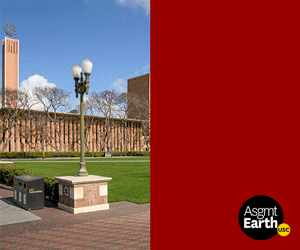On the Vincent Art Price Museum floor, four flower petals — encrusted with seeds that portray the four seasons — invite the visitors to be the center of the flower by standing in the middle of them. Colombian artist Carolina Caycedo and seed doula Azita Banu created this sculpture named “Life at the Center,” where it brings forth a space for intimate observation with every petal and every design trace that the seeds lead.
This piece reflects part of the first section of the exhibition, “We Place Life at the Center.” Caycedo, the leading artist of the project, captured the connections that she established in the convening “Sowing Moisture” with Ruta del Castor in Xochimilco, Mexico. A video of an aquatic landscape and a photograph of a geo-choreography are present, both combining to form an analogy of the human being as a bridge between culture and the environment that sustains it.
If this side of the gallery represents the direct action taken toward the present environmental crisis, then the opposite side provides the foundation of the exhibition’s identity. This foundation is observed with the series “Retratos de plantas,” where flora assumes the central plane of interest, allowing the evaluation of its relationship with humans as individuals. According to Caycedo, the inspiration behind this work comes from her experience with childbirth, which not only limits itself to her body, but has transcended it in an intergenerational manner.
Daily headlines, sent straight to your inbox.
Subscribe to our newsletter to keep up with the latest at and around USC.
“[The] tradition of plant knowledge and curing and medicinal plants has been sustained by women throughout the ages … I’ve experienced it myself … after I gave birth to my second child. [I took some plants] to tonify my uterus … to sustain that life that I had just given birth to,” Caycedo said in English.
Visitors can also appreciate collaborative pieces that highlight the work from organizations such as Coyotl + Macehualli, which serve as calls to action regarding the environmental crisis through documentaries, preservation efforts and research on ecosystems. The theme of justice results from another of Caycedo’s routes of inspiration.
“The people who are on the front lines of environmental justice [are encouraging],” she said. “Even in the face of collapse, of displacement, of genocide, of war, there’s people in the front lines who… [continue] making artwork in the midst of this … brutality.”
By referring to these points of view, the audience might come to the conclusion that the title, “We Place the Life at the Center,” refers to the image of the human being assuming the role of an agent of change against environmental injustices. Nevertheless, VPAM and exhibition curator Joseph Valencia said that far beyond the scope of ecofeminism and environmental inequality, the title incites reflection on how these practices can be promoted in communal decisions.
“The title gives us the opportunity to think about, how do we just shift our language, shift our relationships and the way that we consider nature? … [For example, if] a community makes decisions, the outcome is going to be very different versus if you place profit or capitalism at the center of a process,” Valencia said. “[It’s] a more systemic kind of critique and also proposal.”
This focus on community is reflected in the multidisciplinary ways that Caycedo approaches her artwork in the second section of the exhibition. The colorful suspension of the sculptures that belong to “Bionave Flotilla” invite visitors’ inner child to explore every facade of the figures; the drawing “Lithium Intensive” awakens astonishment and curiosity over the usage of metals within the artwork.
“Cada sorbo de café será una bendición para ti (Tinti)”, a tapestry, alludes to the socioeconomic strifes of Latin American nations on their way to independence, and the video “Fuel to Fire” prompts viewers to reflect on consumerism and how a cycle of restoration to nature can be promoted.
According to Caycedo, the purpose of using different artistic mediums is to bring forth different reactions to the same themes. Similarly, she said art is a method of including and connecting individuals from different conceptual and temporal backgrounds to elicit understanding of the dialogue between the pieces.
“I strongly believe that art is a space for pedagogy and for learning. That’s how I approach artmaking: as a place to either learn or to provide knowledge. It’s not a place to make money, it’s not a place to express my inner feelings,” Caycedo said.
Following this idea, Valencia said the works exhibited are tools to support the fight for the environment.
“[Not only do the artworks] visualize relationships that people have with [their] ecologies, … [but also serve] to document or preserve [an ecosystem] and … to advocate [movements],” he said.
In the same line of thinking, the curator mentioned that advocacy was the impetus for the exhibition’s construction.
“This exhibition was built out of years of fieldwork and research that Carolina conducted … between 2020 and 2024,” Valencia said. “We found that it would be really important to showcase [the] different people and communities and environmental groups that she has been connected with.”
As a closing act to the exhibition in March 2025, Caycedo will lead a geo-choreography at the University that consists of forming the phrases “Just Transition Now” and “Transición Justa Ahora,” which will be captured with a drone. The bodies of 150 participants will contrast against the McCarthy Quad grass, in a performance that will allude to the prominence of human impact on the environment.
This piece will serve as a protest toward the effectiveness of the timeline of solutions to the environmental crisis, and also acknowledges how the act of being “well” is isolating in a capitalist society.
“[The geo-choreography brings] bodies together so we can construct a collective body to remember how good it feels to be close to each other,” Caycedo said. “When we are writing and demanding this ‘Just Transition Now,’ and sending this message to this view from above, we are hacking the view of power too, and we are imprinting a living message over the land that is sustaining us too.”
For Caycedo, art serves to express a positive side of the sociocultural transition on the environment.
“It is horrifying and it’s really depressing [to receive news on environmental collapse],” she said. “Art has the possibility of changing the narrative into [a] more hopeful [one], and also [empower] people to feel that they can do stuff to change this narrative too.”






